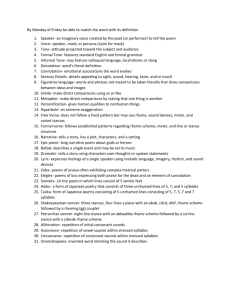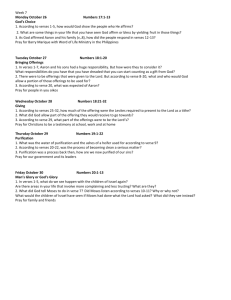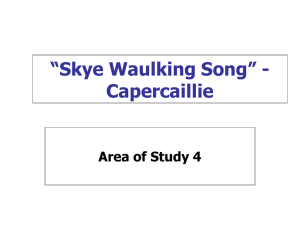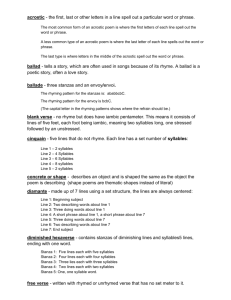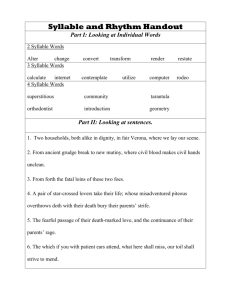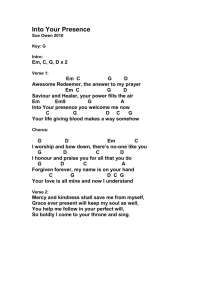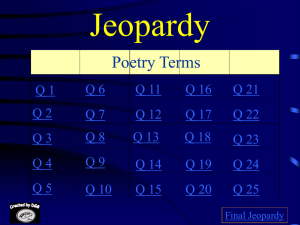doc
advertisement
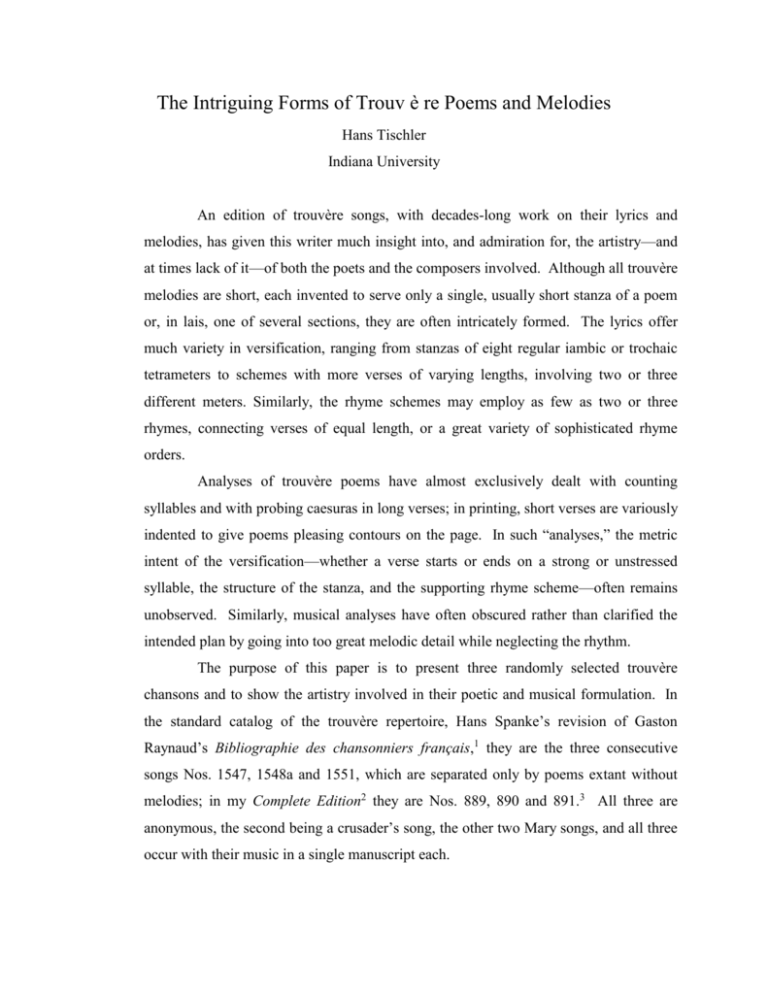
The Intriguing Forms of Trouv è re Poems and Melodies
Hans Tischler
Indiana University
An edition of trouvère songs, with decades-long work on their lyrics and
melodies, has given this writer much insight into, and admiration for, the artistry—and
at times lack of it—of both the poets and the composers involved. Although all trouvère
melodies are short, each invented to serve only a single, usually short stanza of a poem
or, in lais, one of several sections, they are often intricately formed. The lyrics offer
much variety in versification, ranging from stanzas of eight regular iambic or trochaic
tetrameters to schemes with more verses of varying lengths, involving two or three
different meters. Similarly, the rhyme schemes may employ as few as two or three
rhymes, connecting verses of equal length, or a great variety of sophisticated rhyme
orders.
Analyses of trouvère poems have almost exclusively dealt with counting
syllables and with probing caesuras in long verses; in printing, short verses are variously
indented to give poems pleasing contours on the page. In such “analyses,” the metric
intent of the versification—whether a verse starts or ends on a strong or unstressed
syllable, the structure of the stanza, and the supporting rhyme scheme—often remains
unobserved. Similarly, musical analyses have often obscured rather than clarified the
intended plan by going into too great melodic detail while neglecting the rhythm.
The purpose of this paper is to present three randomly selected trouvère
chansons and to show the artistry involved in their poetic and musical formulation. In
the standard catalog of the trouvère repertoire, Hans Spanke’s revision of Gaston
Raynaud’s Bibliographie des chansonniers français,1 they are the three consecutive
songs Nos. 1547, 1548a and 1551, which are separated only by poems extant without
melodies; in my Complete Edition2 they are Nos. 889, 890 and 891.3 All three are
anonymous, the second being a crusader’s song, the other two Mary songs, and all three
occur with their music in a single manuscript each.
2.
The stanza of the first song is unusual in that it has eleven verses but
only two rhyme syllables. All verses have eight syllables. It is evident that the
rhymes must fall on stressed syllables and that the preceding seven syllables are
intended to follow a regular pattern of stresses; the problem is to discover this
pattern. It is further evident that all the stanzas that follow are intended to be
sung to the melody of the first stanza. To establish the intended stress pattern
or meter of the stanza, it is best to see how the usual speech or prose stresses
best fit into such a pattern.
A survey produces the following result:
Example 1a
verses 1, 2, 3, 4, 8, 11 scan
'–'–'––'
verse 5 scans
–'–''––'
verse 6 scans
–'––'––'
verses 7, 9 scan
' – ' – – ' –'
and verse 10 scans
–'–'–'–'
Thus all lines except v. 10 exhibit mixtures of trochees or iambs with dactyls. Adopting
the majority evidence, it appears that applying the pattern of verses 1-4, 8 and 11 to all
verses provides 11 x 4 = 44 stressed syllables, of which nine (indicated in Example 1b
by `) fall on usually weak syllables, i. e. one in about five:
Example 1b
verse 5:
`–`–'––'
verse 6:
` – `– ' – – '
verses 7, 9:
' –' –`– – '
verse 10:
`–`–`––'
According to evidence furnished by the contemporary motets, this is a very acceptable
proportion of so-called wrongly accented syllables and a very normal feature.4
3.
By expanding the survey to the remaining stanzas, it appears that there the poet
frequently falls back into the more usual iambic tetrameters, which do not serve stanza 1
too well. Both readings are well served by the melody, which, however, is notated
without indicating the rhythm, i. e. in premensural symbols—symbols that do not
indicate relative lengths.5
To do justice to the metric poetry, the melody presumably supports it
with the rhythms current in the music of the time other than chants, namely,
those of the rhythmic modes. In general, these rhythms can satisfy the several
simple poetic meters involved in trouvère poetry in various ways:
The choice of mode seems to depend on the most singable, most comfortable
distribution of multi-note figures. (Nota bene: It is the succession of syllables which
reflects the rhythmic pattern, not that of the notes; many syllables carry ornamental
multi-note figures.)
In this song the iambic rendition probably favors mode 1, but the triplet figures
in several phrases introduce an unevenness which may render other versions preferable.
Mode 5 seems too stodgy, though quite possible. The trochaic-dactylic or trochaictribrachic interpretation suggests modes 2+3 or 2+6. This approach hardly admits a 5thmode rendition, because it would lead to uneven phrases. In all renditions, the multinote ornaments comfortably fall on long parts of the pattern or belong to chains of
graceful figurations. All these versions are shown in Example 1d.
4.
5.
Whichever approach is taken, the formulation of this melody is very interesting
and differs from the rhyme scheme. The poetic and musical structures parallel only with
regard to the overall A-A-B formulation, while the syntactic formulation remains
independent from both the musical formulation and the rhyme scheme. The sentences
close in vv. 6 and 8:
Example 1e
rhyme scheme:
ab ab baa bbaa
melody:
a b a b c a' b' c a' b' c'
overall form:
A A B
syntactic form:
-------- ---- ----
The second song is rather clearly cast in regular iambic tetrameters throughout,
but there are again several “misplaced” stresses, here seven of 48 or one in seven (the
neglected stresses are marked by underscoring).
Of the twelve verses of the stanza, the last four form a refrain which is
repeated at the end of all stanzas. The rhyme structure is very simple,
alternating a- and b-rhymes. The rhyme syllables remain the same throughout
all stanzas except in the last one, though not always strictly the same. This
rather amateurish approach is also revealed in the somewhat humdrum melody,
which includes many nonchalant variants. The structure of the melody
nevertheless remains quite sophisticated (Example 2a, and Example 2b).
Example 2a
A(a-b) A'(a-b') A"(a'-b') B(c-d) B'(c-e) B
6.
Example 2b
Only the first of the three songs has the number of stanzas most usual for
trouvère songs namely, five. The second song, just discussed, seems to have seven
stanzas, but stanzas 5 and 6 are preserved incomplete. Our third song has eight stanzas.
Moreover, its first stanza is unusual in that it has, in addition to the three-line refrain,
nine verses, whereas the other seven stanzas contain only seven lines. The refrain (rf) is
sung both at the beginning of stanza 1 and at the end of all stanzas. The meter is
trochaic throughout, employing both strong and weak rhymes, but the verses have
various lengths of 5, 7, and 8 syllables, and an interesting rhyme order (Example 3a).
7.
Example 3a
rf:
a ( ' –' –' ) a a ( ' –' ' –' –' )
b('–'–'–') a('–'–')
b
"
a
"
a('–'–'–') c('–'–'–'–) c
[a('–'–') a('–'–')]
rf:
a ( ' –' –' ) a a ( ' –' ' – ' – ' )
The formulation of the melody is particularly intricate. The trochees admit
approaches in modes 1, 2, or 5. A performance in mode 5 would seem quite acceptable
and in keeping with the religious text; the rich and varied ornamentation provides much
variety. When one tries to apply the livelier modes 1 or 2, however, it appears that
several phrases tend towards one mode, while others to the other, because otherwise the
long figures would fall awkwardly on short beats. Such mixtures of modes, however,
are not unusual in the trouvère repertoire. In Example 3b, both versions are shown.
8.
Example 3b
9.
Of great interest here are the intricate melodic interrelationships
among the phrases, which are indicated above the staves. The most obvious
relationships, despite important rhythmic variants, are listed in Example 3c.
Example 3c
1. verse 2 relates to v. 10
2. verse 3a relates to vv. 4, 7-8,10
3. verse 3b relates to vv. 6, 9, 12
4. verse 5 relates to vv. 8, 11
5. verse 11 relates to v. 12
Because of the varied repeats, which integrate the tune, the melodic form
contradicts that of the poem’s text. The latter, apart from the refrain, has a rather
10.
conventional A A B structure, in which two lines are added to stanza 1. Most of the
melodic phrases derive from the “motives” presented in the refrain. They are arranged
in only two sections, both of three phrases, supporting, respectively, vv. 4-6 and 7-9,
derived from variations of the melody of verse 3 of the refrain. Another verse is added
to the second group of three verses, anticipating the melody of the repeated refrain.
Together with the two phrases unique to stanza 1, which also refer to the melody of
verse 3, this phrase forms a third group of three verses. Thus, the unusual form of the
melody unfolds throughout the song in groups of three verses, whereas the lyrics divide
into 2-2-5 lines framed by a three-line refrain (Example 3d).
Example 3d
lyrics:
(3) - 2 - 2 - 3 + (2) - (3) lines;
melody: (3) - 3 - 3 - 1 + (2) - (3) phrases.
The variety and sophistication in rhythm and structure shown in these three
songs emerge throughout the trouvère repertoire and render most of these songs very
fresh and attractive.
1
Hans Spanke, G. Raynauds Bibliographie des altfranzösischen Liedes. Leiden: E. J. Brill,
1955.
2 Hans Tischler, Trouvère Lyrics with Melodies: Complete Comparative Edition. 15 vols.
CMM 107. Heuhasen-Stuttgart: Hänssler-Verlag, 1997.
3 Respectively in Ms. Paris, Bibl. Nat. fr. 24406 (V), fol. 149v and, with text only, in Ms.
Bern, Stadtbibl. 389 (C), fol. 61v-62r; in Ms. Erfurt, Wissenschaftl. Bibl. (Amploiana) (17), Ms
80 Nr. 329, fol. 88r-v; and in Ms. Paris, Bibl. Nat. fr. 12483 (i), fol. 207v.
4
Hans Tischler, Style and Evolution of the Earliest Motets (to circa 1270), 3 vols. (Institute of
Mediaeval Music, 1985), vol. II, pp. 193 f., 196 f.
5 The melodies of the other two songs also do not indicate the rhythm.
